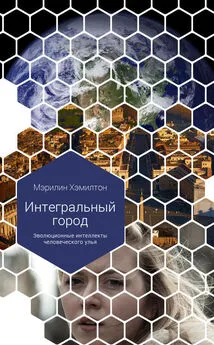Мэрилин Хэмилтон - Интегральный город. Эволюционные интеллекты человеческого улья
- Название:Интегральный город. Эволюционные интеллекты человеческого улья
- Автор:
- Жанр:
- Издательство:Литагент «ИП Баранов»fed4515a-c319-11e4-84ea-002590591dd6
- Год:2013
- Город:Москва
- ISBN:нет данных
- Рейтинг:
- Избранное:Добавить в избранное
-
Отзывы:
-
Ваша оценка:
Мэрилин Хэмилтон - Интегральный город. Эволюционные интеллекты человеческого улья краткое содержание
Каким образом столкновение различий, которые отделяют людей, цели, интересы и приоритеты друг от друга, может генерировать свежую энергию, необходимую для решения проблем двадцать первого века? Где непредсказуемо развиваются взаимосвязи, прокладывающие новые пути для обучения сообществ и дающие новые инструменты в руки городских лидеров и горожан?
В настоящей книге исследуется новая интегральная парадигма для развития городов, которая позволяет ответить на поставленные вопросы. Она прослеживает эволюцию системного, стратегического, социального и строительного интеллектов города и показывает градостроителям, законодателям, горожанам, гражданскому обществу и защитникам окружающей среды, как можно ощущать город, проживать в нём и устанавливать с ним взаимоотношения на основе целостности. В «Интегральном городе» предлагается исследование контекстов географии, экологии и жизненных циклов города. Книга служит читателю путеводителем по интегрированному маршруту по многообразным интеллектам, или линиям развития городской среды.
Интегральный город. Эволюционные интеллекты человеческого улья - читать онлайн бесплатно ознакомительный отрывок
Интервал:
Закладка:
Cook, D. (2005). The Natural Step: Towards A Sustainable Society . Totnes, Devon, UK: Green Books.
Covey, S. R. (1990). The 7 Habits of Highly Effective People . New York: Simon and Shuster.
Cummins, R. A. (1996a). « Assessing Quality of Life .» In Quality of Life for Handicapped People, R. I. Brown (Ed.), London: Chapman & Hall.
Cummins, R. A. (1996b). « The Domains of Life Satisfaction: An Attempt to Order Chaos» . Social Indicators Research, 38.
Cummins, R. A., R. Eckersley, S. K. Lo, M. Davern, B. Hunter, & E. Okerstrom (2004). « The Australian Unity Well-being Index: An Update .» Paper presented at the Proceedings of the 5th Australian Conference on Quality of Life, Deakin University, Melbourne.
D’Adamo, P. J., & C. Whitney (2000). Cook Right 4 Your Type . New York: Berkely Books.
Dale, A. (2001). At The Edge: Sustainable Development in the 21st Century . Vancouver, BC: UBC Press.
Dale, A., & J. Hamilton (2007). « Sustainable Infrastructure » [Electronic Version]. Retrieved February 2008 from crcresearch. org/files-crcresearch/File/SI_Final_ Report. pdf
Dale, A., & J. Onyx (Eds.). (2005). A Dynamic Balance: Social Capital and Sustainable Community Development . Vancouver, BC: UBC Press.
Dale, A., L. Waldron, & L. Newman (2007). Sustainable Community Infrastructure Case Studies . Retrieved March 7, 2007, from www.crcresearch.org/community-research-connections/case-studies-sustainable-infrastructure
Davison, T. (2006). Leisure Services: A Service Delivery Model for the Future . Unpublished thesis, Royal Roads, Victoria, BC.
Dawson-Tunik, T. L., Commons, M. L., Wilson, M., and Fischer, K. W. (2005). The Shape of Development. The European Journal of Development Psychology, 2(2), 163–196.
Dawson, T. (2007). Testing Transformation: Transformation Testing [Electronic Version]. Retrieved from devtestservice.com
Deguire, C. (2005). Internal Communication in the Canadian Navy . Unpublished thesis, Royal Roads University, Victoria, BC.
De Landa, M. (1995). Homes: Meshwork or Hierarchy? Special Home issue. Retrieved December 4, 2004, from mediamatic.net/article-200.5956.html
De Landa, M. (1997). A Thousand Years of Nonlinear History . New York: Zone Books.
De Landa, M. (2006). A New Philosophy of Society: Assemblage Theory and Social Complexity . London: Continuum.
Diamond, J. (2005). Collapse: How Societies Choose to Fail or Succeed . New York: Penguin.
Durning, A. (2004). Cascadia Scorecard . Seattle: Northwest Environment Watch.
Durrance, B. (1997). « From Chaos to Chords: The Evolutionary Vision of Dee Hock .» Training & Development Magazine, 4.
Dutrisac, M., D. Fowke, H. Koplowitz & K. Shepard (nd). Global Organization Design: A Dependable Path to Exceptional Business Results Based on Requisite Organization Principles . Toronto: Global Organization Design Society.
Dychtwald, K. & J. Flower (1989). Age Wave . Los Angeles: Jeremy P. Tarcher.
Eddy, B. (2003a). Personal communication and notes .
Eddy, B. (2003b). « Sustainable Development, Spiral Dynamics and Spatial Data: A «3i» Approach to SD ». Paper presented at the Spiral Dynamics Integral, Level II, Ottawa, 2003.
Eddy, B. (2005). « Place, Space and Perspective ,» World Futures, 61, 151–163.
Eddy, B. (2006). The Use of Maps and Map Metaphors for Integration in Geography: A Case Study of Mapping Indicators of Sustainability and Wellbeing . Unpublished thesis, Dept. of Geography and Environmental Studies, Carleton University, Ottawa.
Eddy, B. (Cartographer). (2007). Mapping Integral Values: A Proof of Concept on Google Earth . Unpublished document.
Ehrlich, P. R. & A. H. Ehrlich (1997). « The Population Explosion: Why We Should Care and What We Should Do About It .» Environmental Law (00462276), 27(4), 1187.
Eoyang, G. (1997). Coping With Chaos: Seven Simple Tools. Cheyenne, WY: Lagumo.
Eoyang, G. (2007). Seeing and Learning Differently: Asset Building and Complex Change . Minneapolis: Search Institute Webinar Series.
Eoyang, G. & E. Olson (2001). Facilitating Organization Change: Lessons from Complexity Science . San Francisco: Jossey-Bass Pfeiffer.
Esborn-Hargens, S. (2005). « Integral Ecology: The What, Who, and How of Environmental Phenomena .» World Futures, 61(1, 2), 5 – 49.
Fainstein, S. & S. Campbell (Eds.). (2003). Readings in Urban Theory . Malden, MA: Blackwell.
Fernandez-Armesto, F. (2001). Civilizations: Culture, Ambition and the Transformation of Nature . New York: Touchstone.
Fisher, M. (2003). Fearless Leadership In and Out of the «Fear» Matrix. Unpublished doctoral dissertation, University of British Columbia, Vancouver, BC.
Florida, R. (2005). Cities and the Creative Class . New York: Routledge.
Foote, D. K. (1999). Boom, Bust & Echo 2000: Profiting from the Demographic Shift in the New Millennium . Toronto: MacFarlane Walter & Ross.
Fourman, M. (2006). Resilience: A complex fractal, global challenge demands a systemic collaborative approach . London, UK: Gaiasoft.
Fourman, M., C. Reynolds, K. Firus & A. D’Ulizia (2008). Online tools for developing sustainability and Resilience: Methodology, experience and cost effective solutions from MIDIR EU Reserch Project . London, UK: European Commission.
Friedman, T. L. (2005). The World Is Flat: A Brief History of the 21st Century . New York: Farrar, Strauss and Giroux.
Fuller, B. (1970). « Technology and the Human Environment. » In The Ecological Conscience: Values for Survival, R. Disch (Ed.), (pp. 174–180). Englewood Cliffs, NJ: Prentice Hall.
Gardner, H. (1999). Intelligence Reframed: Multiple Intelligences for the 21st Century . New York: Basic Books, Perseus Books Group.
Geiken, B., B. Brown & M. Fourman (2005). « Integral Policy Implementation and Follow-Up .» Personal communication.
Global Reporting Initiative. (2006). Reporting Guidelines . Amsterdam: Author.
Goleman, D. (1997). Emotional Intelligence . New York: Bantam.
Gore, A. (2007). An Inconvenient Truth: The Crisis of Global Warming . New York: Viking.
Gottdiener, M. & R. Hutchison (2006). The New Urban Sociology, (3rd ed.). Boulder, CO: Westview Press.
Gould, J. L. & C. G. Gould (1988). The Honey Bee . Scientific American Library.
Gozdz, K., Ed., et al, (1995). Community Building: Renewing Spirit and Learning in Business. San Francisco: New Leaders Press, Sterling & Stone Inc.
Graves, C. (1971). « A Systems Conception of Personality: Levels of Existence Theory. » Paper presented at the Washington School of Psychiatry.
Graves, C. (1974). « Human Nature Prepares for a Momentous Leap .» The Futurist.
Graves, C. (1981). Summary Statement: The Emergent, Cyclical, Double Helix Model of the Adult Human Biopsychosocial Systems . Retrieved July 3, 2002, from www.clarewgraves.com/articles_content/1981_handout/1981_summary.pdf
Graves, C. (2003). Levels of Human Existence . Santa Barbara: ECLET Publishing.
Graves, C. (2005). The Never Ending Quest: A Treatise on an Emergent Cyclical Conception of Adult Behavioral Systems and Their Development . Santa Barbara, CA: ECLET Publishing. Gregory, R. L.,
Ed., et al, (1987). The Oxford Companion to The Mind. Oxford: Oxford University Press.
Grunwald, M. (August 13, 2007). « The Threatening Storm: How Years of Misguided Policies and Bureaucratic Bungling Left New Orleans Defenseless Against Katrina – and Why It May Happen Again .» Time, 19–31.
Gunderson, L. C. & C. S. Holling (Eds.). (2002). Panarchy: Understanding Transformations in Human and Natural Systems . Washington, DC: Island Press.
Habermas, J. (1984). The Theory of Communication . (T. McCarthy, Trans. Vol. 1). Boston: Beacon.
Hagelin, J. (June-August, 2007). « The Power of the Collective .» Shift: At the Frontiers of Consciousness, 15, 16–20.
Hamer, D. (2004). The God Gene: How Faith Is Hardwired into Our Genes . New York: Doubleday. Hamilton, M. (1999). The Berkana Community of Conversations: A Study of Leadership Skill Development and Organizational Leadership Practices in a Self-organizing Online Microworld. Unpublished doctoral dissertation, Columbia Pacific University, Novato, California.
Hamilton, M. (2003). Abbotsford Values Systems Flower Map [Graphical Data]. Retrieved July 24, 2008: www.integralcity.com/files/Spiral.flower.icity.pdf Abbotsford, BC.
Hamilton, M. (2005). « The Quest: Four Questions That Can Release the Potential of Your City .» Paper presented at the Canadian Institute of Planners: Frontiers in Planning and Design, Calgary, AB.
Hamilton, M. (2006a). « Integral Framework for Sustainable Planning: A Prototype for Emergent Well Being .» Paper presented at the World Planners Congress, Vancouver, BC.
Hamilton, M. (2006b). « Integral Meta-map Creates Common Language for Urban Change .» Journal of Organizational Change Management, 19(3), 276–306.
Hamilton, M. (2007a). « Approaching Homelessness: An Integral Reframe. » World Futures: The Journal of General Evolution, 63(2), 107–126.
Hamilton, M. (2007b). Personal Wellbeing Index: Toronto . Abbotsford, BC: Integral City, a Division of TDG Holdings.
Hamilton, M. & A. Dale (2007). Sustainable Infrastructure Development: A Learning Framework . In publication.
Hawken, P. (May 7, 2007). « To Remake the World Something Earth-Changing Is Afoot Among Civil Society .» Orion Magazine.
Hertzman, C., S. A. McLean, D. E. Kohen, J. Dunn & T. Evans (2002). Early Development in Vancouver: Report of the Community Asset Mapping Project (CAMP) . Vancouver, BC: Community Asset Mapping Project UBC.
Hochachka, G. (2005). Developing Sustainability, Developing the Self: An Integral Approach to International and Community Development . University of Victoria, BC: Polis Project on Ecological Governance.
Holling, C. S. (2001). « Understanding the Complexity of Economic, Ecological and Social Systems .» Ecosystems, 4, 390–405.
Holling, C S. (2003). From Complex Regions to Complex Worlds . University of Florida.
Homer-Dixon, T. (2006). The Upside of Down: Catastrophe, Creativity, and the Renewal of Civilization . Toronto: Alfred A. Knopf.
Howard, P. J. (1994). The Owner’s Manual for the Brain: Everyday Applications from Mind-brain Research . Austin, TX: Leornian Press.
Isaacs, W. (1999). Dialogue and the Art of Thinking Together . New York: Currency Doubleday.
Jacobs, J. (1970). Economy of Cities . New York: Vintage.
Jacobs, J. (1992). The Death and Life of Great American Cities . New York: Vintage.
Jacobs, J. (1994). Systems of Survival . New York: First Vintage.
Jacobs, J. (2001). The Nature of Economies . New York: First Vintage.
Jacobs, J. (2004). Dark Age Ahead . New York: Random House.
Jaworski, J. (1996). Synchronicity: The Inner Path of Leadership . San Francisco: Berrett-Koehler.
Johnson, S. (2004). Emergence: The Connected Lives of Ants, Brains, Cities, and Software . New York: Scribener.
Читать дальшеИнтервал:
Закладка:










